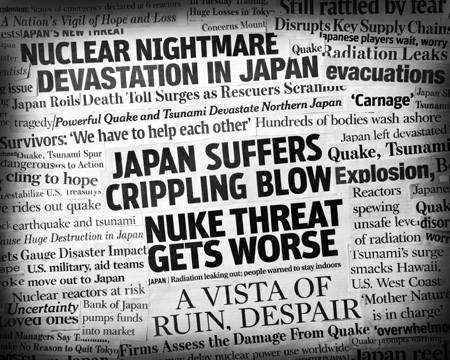
(Photo credit: iStockphotos.com)
Nearly one year after the triple tragedy in Japan, I visited the Sendai region and saw the devastation the tsunami wreaked on the seaside city of Ishinomaki.
Hardworking Japanese have tidied up but there are still mounds of debris and ships that are grounded, swept in from the harbour, miles inland.
Entire neighbourhoods have been reduced to bare earth and many houses are mere shells on weakened columns. Although businesses have restarted, many residents still have yet to secure a permanent home.
Elsewhere in big cities like Tokyo and Nagoya, life seems something like normal. But beneath the surface, there are scars.
Manufacturing has only recently returned to capacity after the disruption of supply chains. Following the Fukushima disaster, most nuclear power stations remain offline and energy saving is critical.
The economy has shrunk and faces new issues especially as manufacturing competitiveness is squeezed by the yen's strength against the US dollar.
The triple tragedy moreover came after decades of no growth, with revolving-door governments, a Mount Fuji of public debt, and an ageing population. So when Japan slipped behind China in economic size, many took this to be inevitable and some have written off the country. Troubled corporate giants like Olympus seem a symbol of the problems.
Yet pathways forward have also emerged in this past year for Japan.
Links to near abroad
First, in response to crisis, the strength of the Japanese people has been re-emphasised. Belief in government may be at a low point--whether the incumbent Democratic Party or the long entrenched Liberal Democratic Party. But many Japanese show steely conviction in volunteering to help those in the tsunami-struck areas-- including the young and many local groups. If community can develop from the ground up, Japan can get beyond the current paralysed politics.
Second, in the outpouring of well wishes and help, the Japanese were reminded of their links to Asia, and vice-versa - as I wrote in my comment in Today not long after the catastrophe on March 11 last year.
While the American alliance remains a cornerstone and incidents over the Senkaku/Diaoyu islands have roiled relations with China, links to the near abroad have increased.
Japan is seriously looking at a free trade agreement with China and South Korea. While there will be difficult negotiations, the underlying economic interdependencies are strong and can be an alternative to the American-led Trans-Pacific Partnership, which is also under consideration.
Even more interesting are Sino-Japanese discussions about currency cooperation even if these are at a preliminary stage for now. As the two largest holders of United States Treasury Bills, if they begin to use currencies other than US dollars, what they agree on will be globally significant.
Other Asians must take heed as Japan and China are key investors and traders and also form the main pillars in the region's financial surveillance and stabilisation mechanisms.
Short-term rebound
ASEAN countries and India will have noted the increased Japanese attention in this past year. Reacting to the supply chain dislocation, many Japanese companies are looking to limit future disruptions by building alternative sources abroad. The high value of the yen and the difficulties with energy supply are other factors.
A new outward push can be anticipated, bringing higher value-added manufacturing and managerial functions. This is opportune given ASEAN's own moves towards a community by 2015, with closer economic integration and greater connectivity.
The triple tragedy of earthquake, tsunami and nuclear plant problems would have killed off many other countries. While affected and still recovering, Japan has more than survived.
Efforts at rebuilding can spur a short-term rebound for the national economy, with relatively positive signs early this year. An impetus to address key issues is also emerging at the corporate level and leading Japanese companies are fundamentally re-strategising.
Many challenges remain, however, as they did before the triple tragedy. It remains to be seen whether this year will be judged as just being the first anniversary of that tragedy, or whether it marks a first and more promisingly step into a new future.

Associate Professor Simon Tay is Chairman of the Singapore Institute of International Affairs and teaches at the Law Faculty of the National University of Singapore. He was in Japan as a member of the Toyota Global Advisory Board. This commentary was originally published in Today.
BY : Simon Tay, SIIA